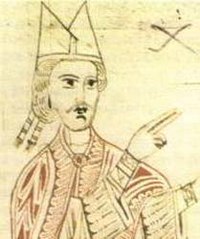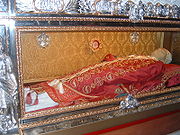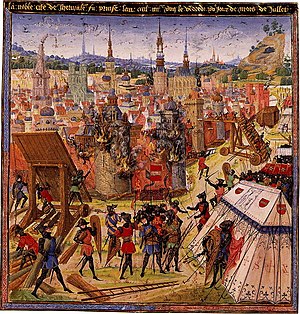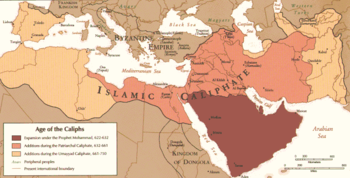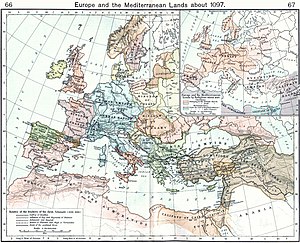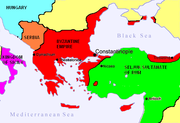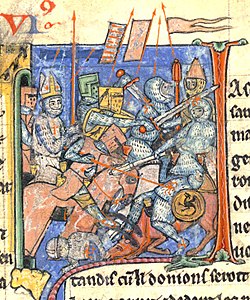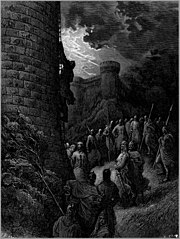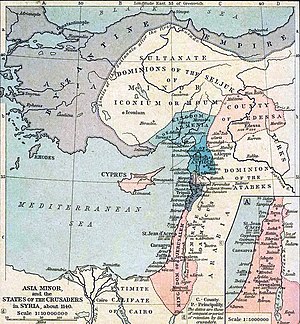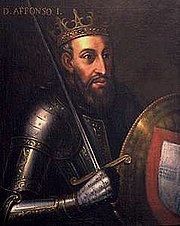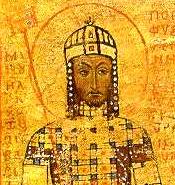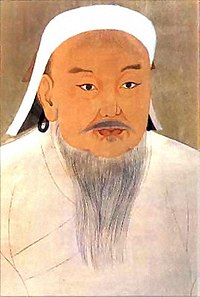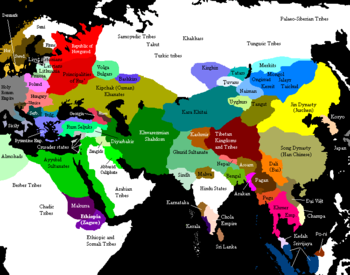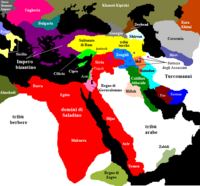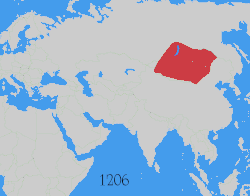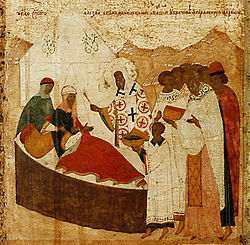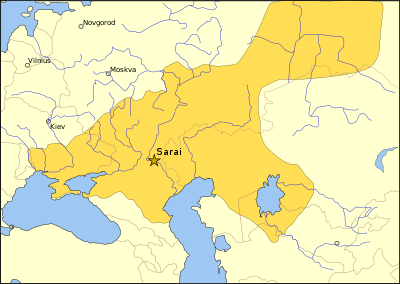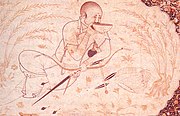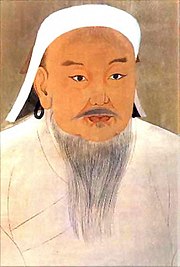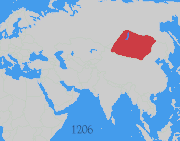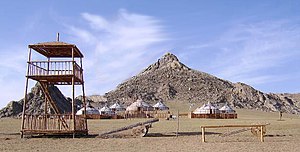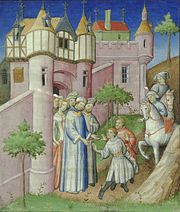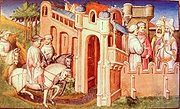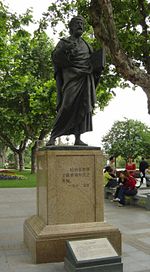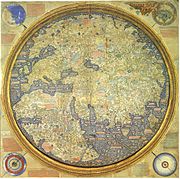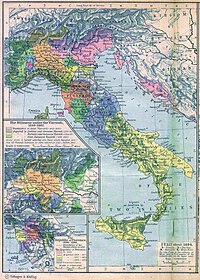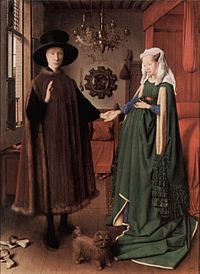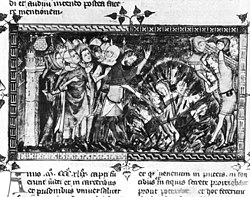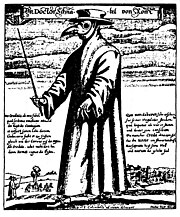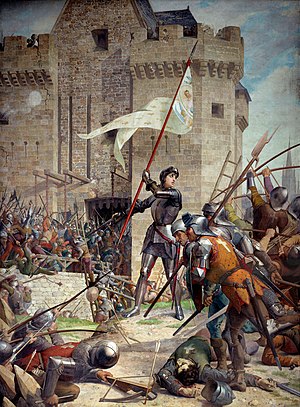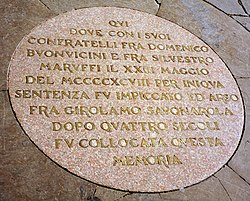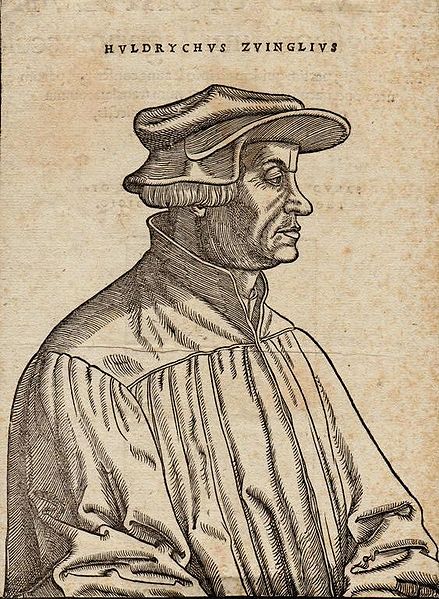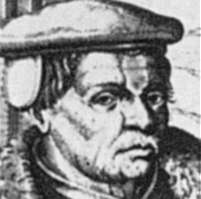From: http://www.bible-researcher.com/wyclif1.html
Schaff's account of Wyclif and the Lollards
The following is reproduced from Philip Schaff's History of the Christian Church (New York: Charles Scribner's Sons, 1910), volume 6 From Boniface viii to Martin Luther. A.D. 1294–1517, chapter 5: "Reformers before the Reformation."
§ 40. John Wyclif.
"A good man was there of religioun
That was a pore Persone of a town;
But rich he was of holy thought and werk;
He was also a lerned man, a clerk,
That Christes gospel trewly wolde preche.
This noble ensample to his shepe he gaf,
That first he wrought and after that he taught.
A better priest I trow that nowhere non is,
He waited after no pompe ne reverence;
Ne maked him no spiced conscience,
But Christes lore and his apostles twelve
He taught, but first he folwed it himselve."553 Chaucer. |
The title, Reformers before the Reformation, has been aptly given to a group of men of the 14th and 15th centuries who anticipated many of the teachings of Luther and the Protestant Reformers. They stand, each by himself, in solitary prominence, Wyclif in England, John Huss in Bohemia, Savonarola in Florence, and Wessel, Goch and Wesel in Northern Germany. To these men the sculptor has given a place on the pedestal of his famous group at Worms representing the Reformation of the 16th century. They differ, if we except the moral reformer, Savonarola, from the group of the German mystics, who sought a purification of life in quiet ways, in having expressed open dissent from the Church’s ritual and doctrinal teachings. They also differ from the group of ecclesiastical reformers, D’Ailly, Gerson, Nicolas of Clamanges, who concerned themselves with the fabric of the canon law and did not go beyond the correction of abuses in the administration and morals of the Church. Wyclif and his successors were doctrinal reformers. In some views they had been anticipated by Marsiglius of Padua and the other assailants of the papacy of the early half of the 14th century.
John Wyclif, called the Morning Star of the Reformation, and, at the time of his death, in England and in Bohemia, the Evangelical doctor,554 was born about 1324 near the village of Wyclif, Yorkshire, in the diocese of Durham.555 His own writings give scarcely a clue to the events of his career, and little can be gathered from his immediate contemporaries. He was of Saxon blood. His studies were pursued at Oxford, which had six colleges. He was a student at Balliol and master of that hall in 1361. He was also connected with Merton and Queen’s, and was probably master of Canterbury Hall, founded by Archbishop Islip.556 He was appointed in succession to the livings of Fillingham, 1363, Ludgershall, 1368, and by the king’s appointment, to Lutterworth, 1374. The living of Lutterworth was valued at £26 a year.
Wyclif occupies a distinguished place as an Oxford schoolman, a patriot, a champion of theological and practical reforms and the translator of the Scriptures into English. The papal schism, occurring in the midst of his public career, had an important bearing on his views of papal authority.
So far as is known, he confined himself, until 1366, to his duties in Oxford and his parish work. In that year he appears as one of the king’s chaplains and as opposed to the papal supremacy in the ecclesiastial affairs of the realm. The parliament of the same year refused Urban V.’s demand for the payment of the tribute, promised by King John, which was back 33 years. John, it declared, had no right to obligate the kingdom to a foreign ruler without the nation’s consent. Wyclif, if not a member of this body, was certainly an adviser to it.557
In the summer of 1374, Wyclif went to Bruges as a member of the commission appointed by the king to negotiate peace with France and to treat with the pope’s agents on the filling of ecclesiastical appointments in England. His name was second in the list of commissioners following the name of the bishop of Bangor. At Bruges we find him for the first time in close association with John of Gaunt, Edward’s favorite son, an association which continued for several years, and for a time inured to his protection from ecclesiastical violence.558
On his return to England, he began to speak as a religious reformer. He preached in Oxford and London against the pope’s secular sovereignty, "running about," as the old chronicler has it, "from place to place, and barking against the Church."559 It was soon after this that, in one of his tracts, he styled the bishop of Rome "the anti-Christ, the proud, worldly priest of Rome, and the most cursed of clippers and cut-purses." He maintained that he "has no more power in binding and loosing than any priest, and that the temporal lords may seize the possessions of the clergy if pressed by necessity." The duke of Lancaster, the clergy’s open foe, headed a movement to confiscate ecclesiastical property. Piers Ploughman had an extensive public opinion behind him when he exclaimed, "Take her lands, ye Lords, and let her live by dimes (tithes)." The Good Parliament of 1376, to whose deliberation Wyclif contributed by voice and pen, gave emphatic expression to the public complaints against the hierarchy.
The Oxford professor’s attitude had become too flagrant to be suffered to go unrebuked. In 1377, he was summoned before the tribunal of William Courtenay, bishop of London, at St. Paul’s, where the proceedings opened with a violent altercation between the bishop and the duke. The question was as to whether Wyclif should take a seat or continue standing in the court. Percy, lord marshal of England, ordered him to sit down, a proposal the bishop pronounced an unheard-of indignity to the court. At this, Lancaster, who was present, swore he would bring down Courtenay’s pride and the pride of all the prelates in England. "Do your best, Sir," was the spirited retort of the bishop, who was a son of the duke of Devonshire. A popular tumult ensued, Wyclif being protected by Lancaster.
Pope Gregory XI. himself now took notice of the offender in a document condemning 19 sentences from his writings as erroneous and dangerous to Church and state. In fact, he issued a batch of at least five bulls, addressed to the archbishop of Canterbury, the bishop of London, the University of Oxford and the king, Edward III. The communication to Archbishop Sudbury opened with an unctuous panegyric of England’s past most glorious piety and the renown of its Church leaders, champions of the orthodox faith and instructors not only of their own but of other peoples in the path of the Lord’s commandments. But it had come to his ears that the Lutterworth rector had "broken forth into such detestable madness as not to shrink from publicly proclaiming false propositions which threatened the stability of the entire Church." His Holiness, therefore, called upon the archbishop to have John sent to prison and kept in bonds till final sentence should be passed by the papal court.560 It seems that the vice-chancellor of Oxford at least made a show of complying with the pope’s command and remanded the heretical doctor to Black Hall, but the imprisonment was only nominal.
Fortunately, the pope might send forth his fulminations to bind and imprison but it was not wholly in his power to hold the truth in bonds and to check the progress of thought. In his letter to the chancellor of Oxford, Gregory alleged that Wyclif was "vomiting out of the filthy dungeon of his heart most wicked and damnable heresies, whereby he hoped to pollute the faithful and bring them to the precipice of perdition, overthrow the Church and subvert the secular estate." The disturber was put into the same category with those princes among errorists, Marsiglius of Padua and John of Jandun.561
The archbishop’s court at Lambeth, before which the offender was now cited, was met by a message from the widow of the Black Prince to stay the proceedings, and the sitting was effectually broken up by London citizens who burst into the hall. At Oxford, the masters of theology pronounced the nineteen condemned propositions true, though they sounded badly to the ear. A few weeks later, March, 1378, Gregory died, and the papal schism broke out. No further notice was taken of Gregory’s ferocious bulls. Among other things, the nineteen propositions affirmed that Christ’s followers have no right to exact temporal goods by ecclesiastical censures, that the excommunications of pope and priest are of no avail if not according to the law of Christ, that for adequate reasons the king may strip the Church of temporalities and that even a pope may be lawfully impeached by laymen.
With the year 1378 Wyclif’s distinctive career as a doctrinal reformer opens. He had defended English rights against foreign encroachment. He now assailed, at a number of points, the theological structure the Schoolmen and medieval popes had laboriously reared, and the abuses that had crept into the Church. The spectacle of Christendom divided by two papal courts, each fulminating anathemas against the other, was enough to shake confidence in the divine origin of the papacy. In sermons, tracts and larger writings, Wyclif brought Scripture and common sense to bear. His pen was as keen as a Damascus blade. Irony and invective, of which he was the master, he did not hesitate to use. The directness and pertinency of his appeals brought them easily within the comprehension of the popular mind. He wrote not only in Latin but in English. His conviction was as deep and his passion as fiery as Luther’s, but on the one hand, Wyclif’s style betrays less of the vivid illustrative power of the great German and little of his sympathetic warmth, while on the other, less of his unfortunate coarseness. As Luther is the most vigorous tract writer that Germany has produced, so Wyclif is the foremost religious pamphleteer that has arisen in England; and the impression made by his clear and stinging thrusts may be contrasted in contents and audience with the scholarly and finished tracts of the Oxford movement led by Pusey, Keble and Newman, the one reaching the conscience, the other appealing to the aesthetic tastes; the one adapted to break down priestly pretension, the other to foster it.
But the Reformer of the 14th century was more than a scholar and publicist. Like John Wesley, he had a practical bent of mind, and like him he attempted to provide England with a new proclamation of the pure Gospel. To counteract the influence of the friars, whom he had begun to attack after his return from Bruges, he conceived the idea of developing and sending forth a body of itinerant evangelists. These "poor priests," as they were called, were taken from the list of Oxford graduates, and seem also to have included laymen. Of their number and the rules governing them, we are in the dark. The movement was begun about 1380, and on the one side it associates Wyclif with Gerrit de Groote, and on the other with Wesley and with his more recent fellow-countryman, General Booth, of the Salvation Army.
Although this evangelistic idea took not the form of a permanent organization, the appearance of the poor preachers made a sensation. According to the old chronicler, the disciples who gathered around him in Oxford were many and, clad in long russet gowns of one pattern, they went on foot, ventilating their master’s teachings among the people and publicly setting them forth in sermons.562 They had the distinction of being arraigned by no less a personage than Bishop Courtenay "as itinerant, unauthorized preachers who teach erroneous, yea, heretical assertions publicly, not only in churches but also in public squares and other profane places, and who do this under the guise of great holiness, but without having obtained any episcopal or papal authorization."
It was in 1381, the year before Courtenay said his memorable words, that Walden reports that Wyclif "began to determine matters upon the sacrament of the altar."563 To attempt an innovation at this crucial point required courage of the highest order. In twelve theses he declared the Church’s doctrine unscriptural and misleading. For the first time since the promulgation of the dogma of transubstantiation by the Fourth Lateran was it seriously called in question by a theological expert. It was a case of Athanasius standing alone. The mendicants waxed violent. Oxford authorities, at the instance of the archbishop and bishops, instituted a trial, the court consisting of Chancellor Berton and twelve doctors. Without mentioning Wyclif by name, the judges condemned as pestiferous the assertions that the bread and wine remain after consecration, and that Christ’s body is present only figuratively or tropically in the eucharist. Declaring that the judges had not been able to break down his arguments, Wyclif went on preaching and lecturing at the university. But in the king’s council, to which he made appeal, the duke of Lancaster took sides against him and forbade him to speak any more on the subject at Oxford. This prohibition Wyclif met with a still more positive avowal of his views in his Confession, which closes with the noble words, "I believe that in the end the truth will conquer."
The same year, the Peasants’ Revolt broke out, but there is no evidence that Wyclif had any more sympathy with the movement than Luther had with the Peasants’ Rising of 1525. After the revolt was over, he proposed that Church property be given to the upper classes, not to the poor.564 The principles, however, which he enunciated were germs which might easily spring up into open rebellion against oppression. Had he not written, "There is no moral obligation to pay tax or tithe to bad rulers either in Church or state. It is permitted to punish or depose them and to reclaim the wealth which the clergy have diverted from the poor?" One hundred and fifty years after this time, Tyndale said, "They said it in Wyclif’s day, and the hypocrites say now, that God’s Word arouseth insurrection."565
Courtenay’s elevation to the see of Canterbury boded no good to the Reformer. In 1382, he convoked the synod which is known in English history as the Earthquake synod, from the shock felt during its meetings. The primate was supported by nine bishops, and when the earth began to tremble, he showed admirable courage by interpreting it as a favorable omen. The earth, in trying to rid itself of its winds and humors, was manifesting its sympathy with the body ecclesiastic.566 Wyclif, who was not present, made another use of the occurrence, and declared that the Lord sent the earthquake "because the friars had put heresy upon Christ in the matter of the sacrament, and the earth trembled as it did when Christ was damned to bodily death."567
The council condemned twenty-four articles, ascribed to the Reformer, ten of which were pronounced heretical, and the remainder to be against the decisions of the Church.568 The four main subjects condemned as heresy were that Christ is not corporally present in the sacrament, that oral confession is not necessary for a soul prepared to die, that after Urban VI.’s death the English Church should acknowledge no pope but, like the Greeks, govern itself, and that it is contrary to Scripture for ecclesiastics to hold temporal possessions. Courtenay followed up the synod’s decisions by summoning Rygge, then chancellor of Oxford, to suppress the heretical teachings and teachers. Ignoring the summons, Rygge appointed Repyngdon, another of Wyclif’s supporters, to preach, and when Peter Stokys, "a professor of the sacred page," armed with a letter from the archbishop, attempted to silence him, the students and tutors at Oxford threatened the Carmelite with their drawn swords.
But Courtenay would permit no trifling and, summoning Rygge and the proctors to Lambeth, made them promise on their knees to take the action indicated. Parliament supported the primate. The new preaching was suppressed, but Wyclif stood undaunted. He sent a Complaint of four articles to the king and parliament, in which he pleaded for the supremacy of English law in matters of ecclesiastical property, for the liberty for the friars to abandon the rules of their orders and follow the rule of Christ, and for the view that on the Lord’s table the real bread and wine are present, and not merely the accidents.569
The court was no longer ready to support the Reformer, and Richard II. sent peremptory orders to Rygge to suppress the new teachings. Courtenay himself went to Oxford, and there is some authority for the view that Wyclif again met the prelate face to face at St. Frideswides. Rigid inquisition was made for copies of the condemned teacher’s writings and those of Hereford. Wyclif was inhibited from preaching, and retired to his rectory at Lutterworth. Hereford, Repyngdon, Aston and Bedeman, his supporters, recanted. The whole party received a staggering blow and with it liberty of teaching at Oxford.570
Confined to Lutterworth, Wyclif continued his labors on the translation of the Bible, and sent forth polemic tracts, including the Cruciata,571 a vigorous condemnation of the crusade which the bishop of Norwich, Henry de Spenser, was preparing in support of Urban VI. against the Avignon pope, Clement VII. The warlike prelate had already shown his military gifts during the Peasants’ Uprising. Urban had promised plenary indulgence for a year to all joining the army. Mass was said and sermons preached in the churches of England, and large sums collected for the enterprise. The indulgence extended to the dead as well as to the living. Wyclif declared the crusade an expedition for worldly mastery, and pronounced the indulgence "an abomination of desolation in the holy place." Spenser’s army reached the Continent, but the expedition was a failure. The most important of Wyclif’s theological treatises, the Trialogus, was written in this period. It lays down the principle that, where the Bible and the Church do not agree, we must obey the Bible, and, where conscience and human authority are in conflict, we must follow conscience.572
Two years before his death, Wyclif received a paralytic stroke which maimed but did not completely disable him. It is possible that he received a citation to appear before the pope. With unabated rigor of conviction, he replied to the supreme pontiff that of all men he was most under obligation to obey the law of Christ, that Christ was of all men the most poor, and subject to mundane authority. No Christian man has a right to follow Peter, Paul or any of the saints except as they imitated Christ. The pope should renounce all worldly authority and compel his clergy to do the same. He then asserted that, if in these views he was found to err, he was willing to be corrected, even by death. If it were in his power to do anything to advance these views by his presence in Rome, he would willingly go thither. But God had put an obstacle in his way, and had taught him to obey Him rather than man. He closed with the prayer that God might incline Urban to imitate Christ in his life and teach his clergy to do the same.
While saying mass in his church, he was struck again with paralysis, and passed away two or three days after, Dec. 29, 1384, "having lit a fire which shall never be put out."573 Fuller, writing of his death, exclaims, "Admirable that a hare, so often hunted with so many packs of dogs, should die quietly sitting in his form."
Wyclif was spare, and probably never of robust health, but he was not an ascetic. He was fond of a good meal. In temper he was quick, in mind clear, in moral character unblemished. Towards his enemies he was sharp, but never coarse or ribald. William Thorpe, a young contemporary standing in the court of Archbishop Arundel, bore testimony that "he was emaciated in body and well-nigh destitute of strength, and in conduct most innocent. Very many of the chief men of England conferred with him, loved him dearly, wrote down his sayings and followed his manner of life."574
The prevailing sentiment of the hierarchy was given by Walsingham, chronicler of St. Albans, who characterized the Reformer in these words: "On the feast of the passion of St. Thomas of Canterbury, John de Wyclif, that instrument of the devil, that enemy of the Church, that author of confusion to the common people, that image of hypocrites, that idol of heretics, that author of schism, that sower of hatred, that coiner of lies, being struck with the horrible judgment of God, was smitten with palsy and continued to live till St. Sylvester’s Day, on which he breathed out his malicious spirit into the abodes of darkness."
The dead man was not left in peace. By the decree of Arundel, Wyclif’s writings were suppressed, and it was so effective that Caxton and the first English printers issued no one of them from the press. The Lateran decree of February, 1413, ordered his books burnt, and the Council of Constance, from whose members, such as Gerson and D’Ailly, we might have expected tolerant treatment, formally condemned his memory and ordered his bones exhumed from their resting-place and "cast at a distance from the sepulchre of the church." The holy synod, so ran the decree, "declares said John Wyclif to have been a notorious heretic, and excommunicates him and condemns his memory as one who died an obstinate heretic."575 In 1429, at the summons of Martin IV., the decree was carried out by Flemmyng, bishop of Lincoln.
The words of Fuller, describing the execution of the decree of Constance, have engraven themselves on the page of English history. "They burnt his bones to ashes and cast them into Swift, a neighboring brook running hardby. Thus this brook hath conveyed his ashes into Avon, Avon into Severn, Severn into the narrow seas, they into the main ocean. And thus the ashes of Wicliffe are the emblem of his doctrine, which now is dispersed the world over."
In the popular judgment of the English people, John Wyclif, in company with John Latimer and John Wesley, probably represents more fully than any other English religious leader, independence of thought, devotion to conscience, solid religious common sense, and the sound exposition of the Gospel. In the history of the intellectual and moral progress of his people, he was the leading Englishman of the Middle Ages.576
§ 41. Wyclif’s Teachings.
Wyclif’s teachings lie plainly upon the surface of his many writings. In each one of the eminent rôles he played, as schoolman, political reformer, preacher, innovator in theology and translator of the Bible, he wrote extensively. His views show progress in the direction of opposition to the medieval errors and abuses. Driven by attacks, he detected errors which, at the outset, he did not clearly discern. But, above all, his study of the Scriptures forced upon him a system which was in contradiction to the distinctively mediaeval system of theology. His language in controversy was so vigorous that it requires an unusual effort to suppress the impulse to quote at great length.
Clear as Wyclif’s statements always are, some of his works are drawn out by much repetition. Nor does he always move in a straight line, but digresses to this side and to that, taking occasion to discuss at length subjects cognate to the main matter he has in hand. This habit often makes the reading of his larger works a wearisome task. Nevertheless, the author always brings the reader back from his digression or, to use a modern expression, never leaves him sidetracked.
I. As a Schoolman.— Wyclif was beyond dispute the most eminent scholar who taught for any length of time at Oxford since Grosseteste, whom he often quotes.577 He was read in Chrysostom, Augustine, Jerome and other Latin Fathers, as well as in the medieval theologians from Anselm to Duns Scotus, Bradwardine, Fitzralph and Henry of Ghent. His quotations are many, but with increasing emphasis, as the years went on, he made his final appeal to the Scriptures. He was a moderate realist and ascribed to nominalism all theological error. He seems to have endeavored to shun the determinism of Bradwardine, and declared that the doctrine of necessity does not do away with the freedom of the will, which is so free that it cannot be compelled. Necessity compels the creature to will, that is, to exercise his freedom, but at that point he is left free to choose.578
II. As a Patriot.—In this role the Oxford teacher took an attitude the very reverse of the attitude assumed by Anselm and Thomas à Becket, who made the English Church a servant to the pope’s will in all things. For loyalty to the Hildebrandian theocracy, Anselm was willing to suffer banishment and à Becket suffered death. In Wyclif, the mutterings of the nation, which had been heard against the foreign regime from the days of William the Conqueror, and especially since King John’s reign, found a stanch and uncompromising mouthpiece. Against the whole system of foreign jurisdiction he raised his voice, as also against the Church’s claim to hold lands, except as it acknowledged the rights of the state. He also opposed the tenure of secular offices by the clergy and, when Archbisbop Sudbury was murdered, declared that he died in sin because he was holding the office of chancellor.
Wyclif’s views on government in Church and state are chiefly set forth in the works On Divine Lordship (De dominio divino) and On Civil Lordship (De dominio civili), and in his Dialogus.579 The Divine Lordship discusses the title by which men hold property and exercise government, and sets forth the distinction between sovereignty and stewardship. Lordship is not properly proprietary. It is stewardship. Christ did not desire to rule as a tenant with absolute rights, but in the way of communicating to others.580 As to his manhood, he was the most perfect of servants.
The Civil Lordship opens by declaring that no one in mortal sin has a right to lordship, and that every one in the state of grace has a real lordship over the whole universe. All Christians are reciprocally lords and servants. The pope, or an ecclesiastical body abusing the property committed to them, may be deprived of it by the state. Proprietary right is limited by proper use. Tithes are an expedient to enable the priesthood to perform its mission. The New Testament does not make them a rule.
From the last portion of the first book of the Civil Lordship, Gregory XI. drew most of the articles for which Wyclif had to stand trial. Here is found the basis for the charge ascribing to him the famous statement that God ought to obey the devil. By this was meant nothing more than that the jurisdiction of every lawful proprietor should be recognized.
III. As a Preacher.— Whether we regard Wyclif’s constant activity in the pulpit, or the impression his sermons made, he must be pronounced by far the most notable of English preachers prior to the Reformation.581 294 of his English sermons and 224 of his Latin sermons have been preserved. To these discourses must be added his English expositions of the Lord’s prayer, the songs of the Bible, the seven deadly sins and other subjects. With rare exceptions, the sermons are based upon passages of the New Testament.
The style of the English discourses is simple and direct. No more plainly did Luther preach against ecclesiastical abuses than did the English Reformer. On every page are joined with practical religious exposition stirring passages rebuking the pope and worldly prelates. They are denounced as anti-christ and the servants of the devil as they turn away from the true work of pasturing Christ’s flock for worldly gain and enjoyment. The preacher condemns the false teachings which are nowhere taught in the Scriptures, such as pilgrimages and indulgences. Sometimes Wyclif seems to be inconsistent with himself, now making light of fasting, now asserting that the Apostles commended it; now disparaging prayers for the dead, now affirming purgatory. With special severity do his sermons strike at the friars who preach out of avarice and neglect to expose the sins of their hearers. No one is more idle than the rich friars, who have nothing but contempt for the poor. Again and again in these sermons, as in his other works, he urges that the goods of the friars be seized and given to the needy classes. Wyclif, the preacher, was always the bold champion of the layman’s rights.
His work, The Pastoral Office, which is devoted to the duties of the faithful minister, and his sermons, lay stress upon preaching as the minister’s proper duty. Preaching he declared the "highest service," even as Christ occupied himself most in that work. And if bishops, on whom the obligation to preach more especially rests, preach not, but are content to have true priests preach in their stead, they are as those that murder Jesus. The same authority which gave to priests the privilege of celebrating the sacrament of the altar binds them to preach. Yea, the preaching of the Word is a more precious occupation than the ministration of the sacraments.582
When the Gospel was preached, as in Apostolic times, the Church grew. Above all things, close attention should be given to Christ’s words, whose authority is superior to all the rites and commandments of pope and friars. Again and again Wyclif sets forth the ideal minister, as in the following description:
"A priest should live holily, in prayer, in desires and thought, in godly conversation and honest teaching, having God’s commandments and His Gospel ever on his lips. And let his deeds be so righteous that no man may be able with cause to find fault with them, and so open his acts that he may be a true book to all sinful and wicked men to serve God. For the example of a good life stirreth men more than true preaching with only the naked word."
The priest’s chief work is to render a substitute for Christ’s miracles by converting himself and his neighbor to God’s law.583 The Sermon on the Mount, Wyclif pronounced sufficient for the guidance of human life apart from any of the requirements and traditions of men.
IV. As a Doctrinal Reformer.— Wyclif’s later writings teem with denials of the doctrinal tenets of his age and indictments against ecclesiastical abuses. There could be no doubt of his meaning. Beginning with the 19 errors Gregory XI. was able to discern, the list grew as the years went on. The Council of Constance gave 45, Netter of Walden, fourscore, and the Bohemian John Lücke, an Oxford doctor of divinity, 266. Cochlaeus, in writing against the Hussites, went beyond all former computations and ascribed to Wyclif the plump sum of 303 heresies, surely enough to have forever covered the Reformer’s memory with obloquy. Fuller suggests as the reason for these variations that some lists included only the Reformer’s primitive tenets or breeders, and others reckoned all the younger fry of consequence derived from them.
The first three articles adduced by the Council of Constance584 had respect to the Lord’s Supper, and charged Wyclif with holding that the substance of the bread remains unchanged after the consecration, that Christ is not in the sacrament of the altar in a real sense, and the accidents of a thing cannot remain after its substance is changed. The 4th article accuses him with declaring that the acts of bishop or priest in baptizing, ordaining and consecrating are void if the celebrant be in a state of mortal sin. Then follow charges of other alleged heresies, such as that after Urban VI. the papacy should be abolished, the clergy should hold no temporal possessions, the friars should gain their living by manual toil and not by begging, Sylvester and Constantine erred in endowing the Church, the papal elections by the cardinals were an invention of the devil, it is not necessary to salvation that one believe the Roman church to be supreme amongst the churches and that all the religious orders were introduced by the devil.
The most of the 45 propositions represent Wyclif’s views with precision. They lie on the surface of his later writings, but they do not exhaust his dissent from the teachings and practice of his time. His assault may be summarized under five heads: the nature of the Church, the papacy, the priesthood, the doctrine of transubstantiation and the use of the Scriptures.
The Church was defined in the Civil Lordship to be the body of the elect, — living, dead and not yet born, — whose head is Christ. Scarcely a writing has come down to us from Wyclif’s pen in which he does not treat the subject, and in his special treatise On the Church, written probably in 1378, it is defined more briefly as the body of all the elect (congregatio omnium predestinatorum). Of this body, Christ alone is the head. The pope is the head of a local church. Stress is laid upon the divine decree as determining who are the predestinate and who the reprobate.585
Some persons, he said, in speaking of "Holy Church, understand thereby prelates and priests, monks and canons and friars and all that have the tonsure, though they live ever so accursedly in defiance of God’s law." But so far from this being true, all popes cardinals and priests are not among the saved. On the contrary, not even a pope can tell assuredly that he is predestinate. This knows no one on earth. The pope may be a reprobate. Such popes there have been, and it is blasphemy for cardinals and pontiffs to think that their election to office of itself constitutes a title to the primacy of the Church. The curia is a nest of heretics if its members do not follow Christ, a fountain of poison, the abomination of desolation spoken of in the sacred page. Gregory XI Wyclif called a terrible devil (horrendus diabolus). God in His mercy had put him to death and dispersed his confederates, whose crimes Urban VI had revealed.586
Though the English Reformer never used the terms visible and invisible Church, he made the distinction. The Church militant, he said, commenting on John 10:26, is a mixed body. The Apostles took two kinds of fishes, some of which remained in the net and some broke away. So in the Church some are ordained to bliss and some to pain, even though they live godly for a while.587 It is significant that in his English writings Wyclif uses the term "Christian men" instead of the term "the faithful."
As for the papacy, no one has used more stinging words against individual popes as well as against the papacy as an institution than did Wyclif. In the treatises of his last years and in his sermons, the pope is stigmatized as anti-Christ. His very last work, on which he was engaged when death overtook him, bore the title, Anti-christ, meaning the pope. He went so far as to call him the head-vicar of the fiend.588 He saw in the papacy the revelation of the man of sin. The office is wholly poisonous (totum papale officium venenosum). He heaped ridicule upon the address "most holy father." The pope is neither necessary to the Church nor is he infallible. If both popes and all their cardinals were cast into hell, believers could be saved as well without them. They were created not by Christ but by the devil. The pope has no exclusive right to declare what the Scriptures teach, or proclaim what is the supreme law. His absolutions are of no avail unless Christ has absolved before. Popes have no more right to excommunicate than devils have to curse. Many of them are damned (multi papae sunt dampnati). Strong as such assertions are, it is probable that Wyclif did not mean to cast aside the papacy altogether. But again and again the principle is stated that the Apostolic see is to be obeyed only so far as it follows Christ’s law.589
As for the interpretation of Matthew 16:18, Wyclif took the view that "the rock" stands for Peter and every true Christian. The keys of the kingdom of heaven are not metal keys, as popularly supposed, but spiritual power, and they were committed not only to Peter, but to all the saints, "for all men that come to heaven have these keyes of God."590 Towards the pope’s pretension to political functions, Wyclif was, if possible, more unsparing. Christ paid tribute to Caesar. So should the pope. His deposition of kings is the tyranny of the devil. By disregarding Peter’s injunction not to lord it over God’s heritage, but to feed the flock, he and all his sect prove themselves hardened heretics.
Constantine’s donation, the Reformer pronounced the beginning of all evils in the Church. The emperor was put up to it by the devil. It was his new trick to have the Church endowed.591 Chapter after chapter of the treatise on the Church calls upon the pope, prelates and priests to return to the exercise of spiritual functions. They had become the prelates and priests of Caesar. As the Church left Christ to follow Caesar, so now it should abandon Caesar for Christ. As for kissing the pope’s toe, there is no foundation for it in Scripture or reason.
The pope’s practice of getting money by tribute and taxation calls forth biting invective. It was the custom, Wyclif said, to solemnly curse in the parish churches all who clipped the king’s coins and cut men’s purses. From this it would seem, he continued, that the proud and worldly priest of Rome and all his advisers were the most cursed of clippers and cut-purses, for they drew out of England poor men’s livelihoods and many thousands of marks of the king’s money, and this they did for spiritual favors. If the realm had a huge hill of gold, it would soon all be spent by this proud and worldly priest-collector. Of all men, Christ was the most poor, both in spirit and in goods, and put from him all manner of worldly lordship. The pope should leave his authority to worldly lords, and speedily advise his clergy to do the same. "I take it, as a matter of faith, that no man should follow the pope, nor even any of the saints in heaven, except as they follow Christ."592
The priests and friars formed another subject of Wyclif’s vigorous attack. Clerics who follow Christ are true priests and none other. The efficacy of their acts of absolution of sins depends upon their own previous absolution by Christ. The priest’s function is to show forgiveness, already pronounced by God, not to impart it. It was, he affirmed, a strange and marvellous thing that prelates and curates should "curse so faste," when Christ said we should bless rather than reprove. A sentence of excommunication is worse than murder.
The rule of auricular confession Wyclif also disparaged. True contrition of heart is sufficient for the removal of sins. In Christ’s time confession of man to man was not required. In his own day, he said, "shrift to God is put behind; but privy (private) shrift, a new-found thing, is authorized as needful for the soul’s health." He set forth the dangers of the confessional, such as the unchastity of priests. He also spoke of the evils of pilgrimages when women and men going together promiscuously were in temptation of great "lecherie."593 Clerical celibacy, a subject the Reformer seldom touched upon, he declared, when enforced, is against Scripture, and as under the Old Testament law priests were allowed to marry, so under the New Testament the practice is never forbidden, but rather approved.
Straight truth-telling never had a warmer champion than Wyclif. Addressing the clergy, he devotes nearly a hundred pages of his Truth of Scripture to an elaboration of this principle. Not even the most trifling sin is permissible as a means of averting a greater evil, either for oneself or one’s neighbor. Under no circumstances does a good intention justify a falsehood. The pope himself has no right to tolerate or practice misrepresentation to advance a good cause. To accomplish a good end, the priest dare not even make a false appeal to fear. All lying is of itself sin, and no dispensation can change its character.594
The friars called forth the Reformer’s keenest thrusts, and these increased in sharpness as he neared the end of his life. Quotations, bearing on their vices, would fill a large volume. Entire treatises against their heresies and practices issued from his pen. They were slavish agents of the pope’s will; they spread false views of the eucharist; they made merchandise of indulgences and letters of fraternity which pretended to give the purchasers a share in their own good deeds here and at the final accounting. Their lips were full of lies and their hands of blood. They entered houses and led women astray; they lived in idleness; they devoured England.595
The Reformer had also a strong word to say on the delusion of the contemplative life as usually practised. It was the guile of Satan that led men to imagine their fancies and dreamings were religious contemplation and to make them an excuse for sloth. John the Baptist and Christ both left the desert to live among men. He also went so far as to demand that monks be granted the privilege of renouncing the monkish rule for some other condition where they might be useful.596
The four mendicant orders, the Carmelites, Augustinians, Jacobites or Dominicans, and Minorites or Franciscans gave their first letters to the word Caim, showing their descent from the first murderer. Their convents, Wyclif called Cain’s castles. His relentless indignation denounced them as the tail of the dragon, ravening wolves, the sons of Satan, the emissaries of anti-christ and Luciferians and pronounced them worse than Herod, Saul and Judas. The friars repeat that Christ begged water at the well. It were to their praise if they begged water and nothing else.597
With the lighter hand of ridicule, Chaucer also held up the mendicants for indictment. In the Prologue to his Canterbury Tales he represents the friar as an—
... easy man to yeve penaunce,
Ther as he wiste to have a good pitaunce
For unto a powre order for to give
Is signe that a man is well y-shrive.
His wallet lay biforn him in his lappe
Bretful of pardoun come from Rome all hoot,
A voys he hadde as smal as hath a goot
Ne was ther swich another pardonour
For in his male he hadde a pilwe-beer [pillow]
Which that, he seyde, was our Lady’s veyl:
And in a glas he hadde a pigges bones. Skeat’s ed., 4:7, 21. |
If it required boldness to attack the powerful body of the monks, it required equal boldness to attack the medieval dogma of transubstantiation. Wyclif himself called it a doctrine of the moderns and of the recent Church (novella ecclesia). In his treatise on the eucharist, he praised God that he had been delivered from its laughable and scandalous errors.598 The dogma of the transmutation of the elements he pronounced idolatry, a lying fable. His own view is that of the spiritual presence. Christ’s body, so far as its dimensions are concerned, is in heaven. It is efficaciously or virtually in the host as in a symbol.599 This symbol "represents" (vicarius est) the body.
Neither by way of impanation nor of identification, much less by way of transmutation, is the body in the host. Christ is in the bread as a king is in all parts of his dominions and as the soul is in the body. In the breaking of the bread, the body is no more broken than the sunbeam is broken when a piece of glass is shattered: Christ is there sacramentally, spiritually, efficiently (sacramentaliter, spiritualiter et virtualiter). Transubstantiation is the greatest of all heresies and subversive of logic, grammar and all natural science.600
The famous controversy as to whether a mouse, partaking of the sacramental elements, really partakes of Christ’s body is discussed in the first pages of the treatise on the eucharist. Wyclif pronounces the primary assumption false, for Christ is not there in a corporal manner. An animal, in eating a man, does not eat his soul. The opinion that the priest actually breaks Christ’s body and so breaks his neck, arms and other members, is a shocking error. What could be more shocking (horribilius), he says, than that the priest should daily make and consecrate the Lord’s body, and what more shocking than to be obliged to eat Christ’s very flesh and drink his very blood. Yea, what could be thought of more shocking than that Christ’s body may be burned or eructated, or that the priest carries God in bodily form on the tips of his fingers. The words of institution are to be taken in a figurative sense. In a similar manner, the Lord spoke of himself as the seed and of the world as the field, and called John, Elijah, not meaning that the two were one person. In saying, I am the vine, he meant that the vine is a symbol of himself.
The impossibility of the miracle of elemental transmutation, Wyclif based on the philosophical principle that the substance of a thing cannot be separated from its accidents. If accidents can exist by themselves, then it is impossible to tell what a thing is or whether it exists at all. Transubstantiation would logically demand transaccidentation, an expression the English Reformer used before Luther. The theory that the accidents remain while the substance is changed, he pronounced "grounded neither in holy writt ne reson ne wit but only taughte by newe hypocritis and cursed heretikis that magnyfyen there own fantasies and dremes."601
Another proof of Wyclif’s freedom of mind was his assertion that the Roman Church, in celebrating the sacrament, has no right to make a precise form of words obligatory, as the words of institution differ in the different accounts of the New Testament. As for the profitable partaking of the elements, he declared that the physical eating profits nothing except the soul be fed with love. Announcing it as his expectation that he would be set upon for his views, he closed his notable treatise on the eucharist with the words, The truth of reason will prevail over all things.
Super omnia vincit veritas rationis.
In these denials of the erroneous system of the medieval Church at its vital points, Wyclif was far in advance of his own age and anticipated the views of the Protestant Reformers.
§ 42. Wyclif and the Scriptures.
Wyclif’s chief service for his people, next to the legacy of his own personality, was his assertion of the supreme authority of the Bible for clergy and laymen alike, and his gift to them of the Bible in their own tongue. His statements, setting forth the Scriptures as the clear and sufficient manual of salvation, and insisting that the literal sense gives their plain meaning, were as positive and unmistakable as any made by Luther. In his treatise on the value and authority of the Scriptures, with 1000 printed pages,602 more is said about the Bible as the Church’s appointed guidebook than was said by all the medieval theologians together. And none of the Schoolmen, from Anselm and Abelard to Thomas Aquinas and Duns Scotus, exalted it to such a position of preëminence as did he. With one accord they limited its authority by coördinating with its contents tradition, that is, the teachings of the Church. This man, with unexcelled precision and cogency, affirmed its final jurisdiction, as the law of God, above all authorities, papal, decretist or patristic. What Wyclif asserts in this special treatise, he said over again in almost every one of his works, English and Latin. If possible, he grew more emphatic as his last years went on, and his Opus evangelicum, probably his very last writing, abounds in the most positive statements language is capable of.
To give the briefest outline of the Truth of Scripture will be to state in advance the positions of the Protestant Reformers in regard to the Bible as the rule of faith and morals. To Wyclif the Scriptures are the authority for every Christian tenet. They are the Law of Christ, the Law of God, the Word of God, the Book of Life. They are the immaculate law of the Lord, most true, most complete and most wholesome.603 All things necessary to belief for salvation are found in them. They are the Catholic faith, the Christian faith, the primal rule of human perfection, the primal foundation of the Christian proclamation.
This book is the whole truth which every Christian should study.604 It is the measure and standard of all logic. Logic, as in Oxford, changes very frequently, yea, every twenty years, but the Scriptures are yea, yea and nay, nay. They never change. They stand to eternity.605 All logic, all law, all philosophy and all ethic are in them. As for the philosophy of the pagan world, whatever it offers that is in accord with the Scriptures is true. The religious philosophy which the Christian learns from Aristotle he learns because it was taught by the authors of Scripture.606 The Greek thinker made mistakes, as when he asserted that creation is eternal. In several places Wyclif confesses that he himself had at one time been led astray by logic and the desire to win fame, but was thankful to God that he had been converted to the full acceptance of the Scriptures as they are and to find in them all logic.
All through this treatise, and in other works, Wyclif contends against those who pronounced the sacred writings irrational or blasphemous or abounding in errors and plain falsehoods. Such detractors he labelled modern or recent doctors (moderni novelli doctores). Charges such as these would seem well-nigh incredible, if Wyclif did not repeat them over and over again. They remind us of the words of the priest who told Tyndale, 150 years later, "It were better to be without God’s laws than to be without the pope’s." What could be more shocking, exclaimed Wyclif, than to assert that God’s words are false.607
The supreme authority of the Scriptures appears from their contents, the beneficent aim they have in view, and from the witness borne to them by Christ. God speaks in all the books. They are one great Word of God. Every syllable of the two Testaments is true, and the authors were nothing more than scribes or heralds.608 If any error seem to be found in them, the error is due to human ignorance and perverseness. Nothing is to be believed that is not founded upon this book, and to its teachings nothing is to be added.609
Wyclif devotes much time to the principles of biblical exposition and brushes away the false principles of the Fathers and Schoolmen by pronouncing the "literal verbal sense" the true one. On occasion, in his sermons, he himself used the other senses, but his sound judgment led him again and again to lay emphasis upon the etymological meaning of words as final. The tropological, anagogical and allegorical meanings, if drawn at all, must be based upon the literal meaning. Wyclif confessed his former mistake of striving to distinguish them with strict precision. There is, in fact, only one sense of Scripture, the one God himself has placed in it as the book of life for the wayfaring man.610 Heresy is the contradiction of Scripture. As for himself, Wyclif said, he was ready to follow its teachings, even unto martyrdom, if necessary.611
For hundreds of years no eminent teacher had emphasized the right of the laity to the Word of God. It was regarded as a book for the clergy, and the interpretation of its meaning was assumed to rest largely with the decretists and the pope. The Council of Toulouse, 1229, had forbidden the use of the Bible to laymen. The condemned sects of the 12th and 13th centuries, especially the Waldenses, had adopted another rule, but their assailants, such as Alanus ab Insulis, had shown how dangerous their principle was. Wyclif stood forth as the champion of an open Bible. It was a book to be studied by all Christians, for "it is the whole truth." Because it was given to the Church, its teachings are free to every one, even as is Christ himself.612
To withhold the Scriptures from the laity is a fundamental sin. To make them known in the mother-tongue is the first duty of the priest. For this reason priests ought always to be familiar with the language of the people. Wyclif held up the friars for declaring it heresy to translate God’s law into English and make it known to laymen. He argued against their position by referring to the gift of tongues at Pentecost and to Jerome’s translation, to the practice of Christ and the Apostles who taught peoples in their native languages and to the existence in his own day of a French translation made in spite of all hindrances. Why, he exclaims, "should not Englishmen do the same, for as the lords of England have the Bible in French, it would not be against reason if they had the same material in English." Through an English Bible Englishmen would be enabled best "to follow Christ and come to heaven."613 What could be more positive than the following words?
Christian men and women, old and young, should study closely the New Testament, and no simple man of wit should be afraid unduly to study in the text of holy Writ. The pride and covetousness of the clerics is the cause of their blindness and heresy and it prevents them from truly understanding holy Writ. The New Testament is of full authority and open to the understanding of simple men, as to the points that be most needful to salvation.
Wyclif was the first to give the Bible to his people in their own tongue. He knew no Hebrew and probably no Greek. His version, which was made from the Latin Vulgate, was the outgrowth of his burning desire to make his English countrymen more religious and more Christian. The paraphrastic translation of books which proceeded from the pen of Richard Rolle and perhaps a verse of the New Testament of Kentish origin and apparently made for a nunnery,614 must be considered as in no wise in conflict with the claim of priority made for the English Reformer. In his task he had the aid of Nicolas Hereford, who translated the Old Testament and the Apocryphal books as far as Baruch 3:20. A revision was made of Wyclif’s Bible soon after his death, by Purvey. In his prologue, Purvey makes express mention of the "English Bible late translated," and affirms that the Latin copies had more need of being corrected than it. One hundred and seventy copies of these two English bibles are extant, and it seems strange that, until the edition issued by Forshall and Madden in 1850, they remained unprinted.615 The reason for their not being struck off on the presses of Caxton and other early English printers, who issued the Golden Legend, with its fantastic and often gruesome religious tales, was that Wyclif had been pronounced a heretic and his version of the Scriptures placed under the ban by the religious authorities in England.
A manuscript preserved in the Bodleian, Forshall and Madden affirm to be without question the original copy of Hereford himself. These editors place the dates of the versions in 1382 and 1388. Purvey was a Lollard, who boarded under Wyclif’s roof and, according to the contemporary chronicler, Knighton, drank plentifully of his instructions. He was imprisoned, but in 1400 recanted, and was promoted to the vicarage of Hythe. This preferment he resigned three years later. He was imprisoned a second time by Archbishop Chichele, 1421, was alive in 1427, and perhaps died in prison.
To follow the description given by Knighton in his Chronicle, the gift of the English Bible was regarded by Wyclif’s contemporaries as both a novel act and an act of desecration. The irreverence and profanation of offering such a translation was likened to the casting of pearls before swine. The passage in Knighton, who wrote 20 years after Wyclif’s death, runs thus:
The Gospel, which Christ bequeathed to the clergy and doctors of the Church — as they in turn give it to lay and weaker persons — this Master John Wyclif translated out of the Latin into the Anglican tongue, not the Angelic tongue, so that by him it is become common, and more open to the lay folk and to women, knowing how to read, than it used to be to clerics of a fair amount of learning and of good minds. Thus, the Gospel pearl is cast forth and trodden under foot of swine, and what was dear to both clergy and laity is now made a subject of common jest to both, and the jewel of the clergy is turned into the sport of the laity, so that what was before to the clergy and doctors of the Church a divine gift, has been turned into a mock Gospel [or common thing].616
The plain meaning of this statement seems to be that Wyclif translated at least some of the Scriptures, that the translation was a novelty, and that it was thought that English was not a proper language for the embodiment of the sacred Word. It was a cleric’s book; and profane temerity, by putting it within the reach of the laity, had vulgarized it.
The work speedily received reprobation at the hands of the Church authorities. A bill presented in the English parliament, 1391, to condemn English versions, was rejected through the influence of the duke of Lancaster, but an Oxford synod, of 1408, passed the ominous act, that upon pain of greater excommunication, no man, by his own authority, should translate into English or any other tongue, until such translation were approved by the bishop, or, if necessary, by the provincial council. It distinctly mentions the translation "set forth in the time of John Wyclif." Writing to John XXIII, 1412, Archbishop Arundel took occasion to denounce "that pestilent wretch of damnable memory, yea, the forerunner and disciple of anti-christ who, as the complement of his wickedness, invented a new translation of the Scriptures into his mother-tongue."617
In 1414, the reading of the English Scriptures was forbidden upon pain of forfeiture "of land, cattle, life and goods from their heirs forever." Such denunciations of a common English version were what Wyclif’s own criticisms might have led us to expect, and quite in consonance with the decree of the Synod of Toulouse, 1229; and Arundel’s reprobation has been frequently matched by prelatical condemnation of vernacular translations of the Bible and their circulation down to the papal fulminations of the 19th century against Bible societies, as by Pius VII, 1816, who declared them "fiendish institutions for the undermining of the foundation of religion." The position, taken by Catholic apologists, that the Catholic hierarchy has never set itself against the circulation of the Scriptures in the vernacular, but only against unauthorized translations, would be adapted to modify Protestantism’s notion of the matter, if there were some evidence of only a limited attempt to encourage Bible study among the laity of the Catholic Church with the pages of Scripture open before them. If we go to the Catholic countries of Southern Europe and to South America, where her away has been unobstructed, the very opposite is true.
In the clearest language, Wyclif charged the priestly authorities of his time with withholding the Word of God from the laity, and denying it to them in the language the people could understand. And the fact remains that, from his day until the reign of Elizabeth, Catholic England did not produce any translations of the Bible, and the English Reformers were of the opinion that the Catholic hierarchy was irrevocably set against English versions. Tyndale had to flee from England to translate his New Testament, and all the copies of the first edition that could be collected were burnt on English soil. And though it is alleged that Tyndale’s New Testament was burnt because it was an "unauthorized" translation, it still remains true that the hierarchy made no attempt to give the Bible to England until long after the Protestant Reformation had begun and Protestantism was well established.
The copies of Wyclif’s and Purvey’s versions seem to have been circulated in considerable numbers in England, and were in the possession of low and high. The Lollards cherished them. A splendid copy was given to the Carthusians of London by Henry VI, and another copy was in the possession of Henry VII. Sir Thomas More states distinctly that there was found in the possession of John Hunne, who was afterwards burnt, a Bible "written after Wyclif’s copy and by him translated into our tongue."618 While for a century and a half these volumes helped to keep alive the spirit of Wyclif in England, it is impossible to say how far Wyclif’s version influenced the Protestant Reformers. In fact, it is unknown whether they used it at all. Some of its words, such as "mote" and "beam" and "strait gate," which are found in the version of the 16th century, seem to indicate, to say the least, that these terms had become common property through the medium of Wyclif’s version.619 The priceless heirloom which English-speaking peoples possess in the English version and in an open Bible free to all who will read, learned and unlearned, lay and cleric, will continue to be associated with the Reformer of the 14th century. As has been said by one of the ablest of recent Wyclif students, Buddensieg, the call to honor the Scriptures as the Word of God and to study and diligently obey them, runs through Wyclif’s writings like a scarlet thread.620 Without knowing it, he departed diametrically from Augustine when he declared that the Scriptures do not depend for their authority upon the judgment of the Church, but upon Christ.
In looking over the career and opinions of John Wyclif, it becomes evident that in almost every doctrinal particular did this man anticipate the Reformers. The more his utterances are studied, the stronger becomes this conviction. He exalted preaching; he insisted upon the circulation of the Scriptures among the laity; he demanded purity and fidelity of the clergy; he denied infallibility to the papal utterances, and went so far as to declare that the papacy is not essential to the being of the Church. He defined the Church as the congregation of the elect; he showed the unscriptural and unreasonable character of the doctrine of transubstantiation; he pronounced priestly absolution a declarative act. He dissented from the common notion about pilgrimages; he justified marriage on biblical grounds as honorable among all men; he appealed for liberty for the monk to renounce his vow, and to betake himself to some useful work.
The doctrine of justification by faith Wyclif did not state. However, he constantly uses such expressions as, that to believe in Christ is life. The doctrine of merit is denied, and Christ’s mediation is made all-sufficient. He approached close to the Reformers when he pronounced faith "the supreme theology" (fides est summa theologia), and that only by the study of the Scriptures is it possible to become a Christian.621
Behind all Wyclif’s other teaching is his devotion to Christ and his appeal to men to follow Him and obey His law. It is scarcely an exaggeration to say that the name of Christ appears on every page of his writings. To him, Christ was the supreme philosopher, yea, the content of all philosophy.622
In reaching his views Wyclif was, so far as we know, as independent as any teacher can well be. There is no indication that he drew from any of the medieval sects, as has been charged, nor from Marsiglius and Ockam. He distinctly states that his peculiar views were drawn not from Ockam but from the Scriptures.623
The Continental Reformers did not give to Wyclif the honor they gave to Huss. Had they known more about him, they might have said more.624 Had Luther had access to the splendid shelf of volumes issued by the Wyclif Society, he might have said of the English Reformer what he said of Wessel’s Works when they were put into his hands. The reason why no organized reformation followed Wyclif’s labors is best given when we say, the time was not yet ripe. And, after all the parallelisms are stated between his opinions and the doctrines of the Reformers, it will remain true that, evangelical as he was in speech and patriotic as he was in spirit, the Englishman never ceased to be a Schoolman. Luther was fully a man of the new age.
Note. – The Authorship of the First English Bible. Recently the priority of Wyclif’s translation has been denied by Abbot Gasquet in two elaborate essays, The Old English Bible, pp. 87–155. He also pronounces it to be very doubtful if Wyclif ever translated any part of the Bible. All that can be attempted here is a brief statement of the case. In addition to Knighton’s testimony, which seems to be as plain as language could put it, we have the testimony of John Huss in his Reply to the Carmelite Stokes, 1411, that Wyclif translated the whole Bible into English. No one contends that Wyclif did as much as this, and Huss was no doubt speaking in general terms, having in mind the originator of the work and the man’s name connected with it. The doubt cast upon the first proposition, the priority of Wyclif’s version, is due to Sir Thomas More’s statement in his Dialogue, 1530 (Works, p. 233). In controverting the positions of Tyndale and the Reformers, he said, "The whole Bible was before Wyclif’s days, by virtuous and well-learned men, translated into English and by good and godly people, with devotion and soberness, well and reverently read." He also says that he saw such copies. In considering this statement it seems very possible that More made a mistake (1) because the statement is contrary to Knighton’s words, taken in their natural sense and Huss’ testimony. (2) Because Wyclif’s own statements exclude the existence of any English version before his own. (3) Because the Lollards associated their Bible with Wyclif’s name. (4) Because before the era of the Reformation no English writer refers to any translating except in connection with Wyclif’s name and time. Sir Thomas More was engaged in controversy and attempting to justify the position that the Catholic hierarchy had not been opposed to translations of the Scriptures nor to their circulation among proper classes of the laity. But Abbot Gasquet, after proposing a number of conjectural doubts and setting aside the natural sense of Knighton’s and Arundel’s statements, denies altogether the Wycliffite authorship of the Bible ascribed to him and edited by Forshall and Madden, and performs the feat of declaring this Bible one of the old translations mentioned by More. It must be stated here, a statement that will be recalled later, that Abbot Gasquet is the representative in England of the school of Janssen, which has endeavored to show that the Catholic Church was in an orderly process of development before Luther arose, and that Luther and the Reformers checked that development and also wilfully misrepresented the condition of the Church of their day. Dr. Gasquet, with fewer plausible facts and less literature at command than Janssen, seeks to present the English Church’s condition in the later Middle Ages as a healthy one. And this he does (1) by referring to the existence of an English medieval literature, still in MSS., which he pronounces vast in its bulk; (2) by absolutely ignoring the statements of Wyclif; (3) by setting aside the testimonies of the English Reformers; (4) by disparaging the Lollards as a wholly humble and illiterate folk. Against all these witnesses he sets up the single witness, Sir Thomas More.
The second proposition advocated by Dr. Gasquet that it is doubtful, and perhaps very improbable, that Wyclif did anything in the way of translating the Bible, is based chiefly upon the fact that Wyclif does not refer to such a translation anywhere in his writings. If we take the abbot’s own high priest among authorities, Sir Thomas More, the doubt is found to be unjustifiable, if not criminal. More, speaking of John Hunne, who was burnt, said that he possessed a copy of the Bible which was "after a Wycliffite copy." (Eadie, I. 6O sqq.); Westcott (Hist. of the Eng. Bible.), Gairdner (who discusses the subject fairly in his Lollardy, I. 101–117), Capes (pp. 125–128), F. D. Matthew (in Eng. Hist. Rev., 1895), and Bigg (Wayside Sketches, p. 127 sq.) take substantially the position taken by the author. Gasquet was preceded by Lingard (Hist. of Eng., IV. 196), who laid stress upon More’s testimony to offset and disparage the honor given from time immemorial to Wyclif in connection with the English Bible.
How can a controversialist be deemed fair who, in a discussion of this kind, does not even once refer to Wyclif’s well-known views about the value of a popular knowledge of the Scriptures, and his urgency that they be given to all the people through plain preaching and in translation? Dr. Gasquet’s attitude to "the strange personality of Wyclif" may be gotten from these words (Old Eng. Bible, p. 88): "Whatever we may hold as Catholics as to his unsound theological opinions, about which there can be no doubt, or, as peace-loving citizens, about his wild revolutionary social theories, on which, if possible, there can be less," etc.
The following are two specimens of Wyclif’s versions:
MATT. VIII. 23–27. And Jhesu steyinge vp in to a litel ship, his disciplis sueden him. And loo! a grete steryng was made in the see, so that the litil ship was hilid with wawis; but he slepte. And his disciplis camen nigh to hym, and raysiden hym, sayinge, Lord, saue vs: we perishen. And Jhesus seith to hem, What ben yhee of litil feith agast? Thanne he rysynge comaundide to the wyndis and the see, and a grete pesiblenesse is maad. Forsothe men wondreden, sayinge: What manere man is he this, for the wyndis and the see obeishen to hym.
ROM. VIII. 5–8. For thei that ben aftir the fleisch saueren tho thingis that ben of the fleisch, but thei that ben aftir the spirit felen tho thingis that ben of the spirit. For the prudence of fleisch: is deeth, but the prudence of spirit: is liif and pees. For the wisdom of fleische is enemye to God, for it is not suget to the lawe of God: for nether it may. And thei that ben in fleisch: moun not please to God.
§ 43. The Lollards.
Although the impulse which Wyclif started in England did not issue there in a compact or permanent organization, it was felt for more than a century. Those who adopted his views were known as Wycliffites or Lollards, the Lollards being associated with the Reformer’s name by the contemporary chroniclers, Knighton and Walsingham, and by Walden.625 The former term gradually gave way to the latter, which was used to embrace all heretics in England.
The term "Lollards" was transplanted to England from Holland and the region around Cologne. As early as 1300 Lollard heretics were classed by the authorities with the Beghards, Beguines, Fratricelli, Swestriones and even the Flagellants, as under the Church’s ban. The origin of the word, like the term Hugenots, is a matter of dispute. The derivation from the Hollander, "Walter Lollard," who was burnt in Cologne, 1322, is now abandoned.626 Contemporaries derived it from lolium (tares), and referred it to the false doctrine these sectarists were sowing, as does Knighton, and probably also Chaucer, or, with reference to their habit of song, from the Latin word laudare, to praise.627 The most natural derivation is from the Low German, lullen or einlullen, to sing to sleep, whence our English lullaby. None of the Lollard songs have come down to us. Scarcely a decade after Wyclif’s death a bull was issued by Boniface IX, 1396, against the "Lullards or Beghards" of the Low Countries.
The Wycliffite movement was suppressed by a rigid inquisition, set on foot by the bishops and sanctioned by parliament. Of the first generation of these heretics down to 1401, so far as they were brought to trial, the most, if not all, of them recanted. The 15th century furnished a great number of Lollard trials and a number of Lollard martyrs, and their number was added to in the early years of the 16th century. Active measures were taken by Archbishop Courtenay; and under his successor, Thomas, earl of Arundel, the full force of persecution was let loose. The warlike bishop of Norwich, Henry Spenser, joined heartily in the repressive crusade, swearing to put to death by the flames or by decapitation any of the dissenters who might presume to preach in his diocese. The reason for the general recantations of the first generation of Wyclif’s followers has been found in the novelty of heresy trials in England and the appalling effect upon the accused, when for the first time they felt themselves confronted with the whole power of the hierarchy.628
In 1394, they were strong enough to present a petition in full parliament, containing twelve Conclusions.629 These propositions called the Roman Church the stepmother of the Church in England, declared that many who had priestly ordination were not ordained of God, took up the evils growing out of enforced celibacy, denied Christ’s material presence in the eucharist, condemned pilgrimages and image-worship, and pronounced priestly confession and indulgences measures invented for the profit of the clergy. The use of mitres, crosses, oil and incense was condemned and also war, on the ground that warriors, after the first blood is let, lose all charity, and so "go straight to hell." In addition to the Bible, the document quotes Wyclif’s Trialogus by name.
From about 1390 to 1425, we hear of the Lollards in all directions, so that the contemporary chronicler was able to say that of every two men found on the roads, one was sure to be a Lollard.630 With the accession of Henry IV of Lancaster (1399–1413), a severe policy was adopted. The culminating point of legislation was reached in 1401, when parliament passed the act for the burning of heretics, the first act of the kind in England.631 The statute referred to the Lollards as a new sect, damnably thinking of the faith of the Church in respect to the sacraments and, against the law of God and the Church, usurping the office of preaching. It forbade this people to preach, hold schools and conventicles and issue books. The violators were to be tried in the diocesan courts and, if found guilty and refusing to abjure, were to be turned over to the civil officer and burnt. The burning, so it was stipulated, was to be on a high place where the punishment might be witnessed and the onlookers be struck with fear.
The most prominent personages connected with the earliest period of Wycliffism, Philip Repyngdon, John Ashton, Nicolas Hereford and John Purvey, all recanted. The last three and Wyclif are associated by Knighton as the four arch-heretics.
Repyngdon, who had boldly declared himself at Oxford for Wyclif and his view of the sacrament, made a full recantation, 1382. Subsequently he was in high favor, became chancellor of Oxford, bishop of Lincoln and a cardinal, 1408. He showed the ardor of his zeal by treating with severity the sect whose views he had once espoused.
John Ashton had been one of the most active of Wyclif’s preachers. In setting forth his heretical zeal, Knighton describes him as "leaping up from his bed and, like a dog, ready to bark at the slightest sound." He finally submitted in Courtenay’s court, professing that he "believed as our modur, holy kirke, believes," and that in the sacrament the priest has in his hand Christ’s very body. He was restored to his privileges as lecturer in Oxford, but afterwards fell again into heretical company.632
Hereford, Wyclif’s fellow-translator, appealed to Rome, was condemned there and cast into prison. After two years of confinement, he escaped to England and, after being again imprisoned, made his peace with the Church and died a Carthusian.
In 1389, nine Lollards recanted before Courtenay, at Leicester. The popular preacher, William Swynderby, to whose sermons in Leicester the people flocked from every quarter, made an abject recantation, but later returned to his old ways, and was tried in 1891 and convicted. Whether he was burnt or died in prison, Foxe says, he could not ascertain.
The number suffering death by the law of 1401 was not large in the aggregate. The victims were distributed through the 125 years down to the middle of Henry VIII’s reign. There were among them no clergymen of high renown like Ridley and Latimer. The Lollards were an humble folk, but by their persistence showed the deep impression Wyclif’s teachings had made. The first martyr, the poor chaplain of St. Osythe, William Sawtré, died March 2, 1401, before the statute for burning heretics was passed. He abjured and then returned again to his heretical views. After trying him, the spiritual court ordered the mayor or sheriff of London to "commit him to the fire that he be actually burnt."633 The charges were that he denied the material presence, condemned the adoration of the cross and taught that preaching was the priesthood’s most important duty.
Among other cases of burnings were John Badby, a tailor of Evesham, 1410, who met his awful fate chained inside of a cask; two London merchants, Richard Turming and John Claydon at Smithfield, 1415; William Taylor, a priest, in 1423 at Smithfield; William White at Norwich, 1428; Richard Hoveden, a London citizen, 1430; Thomas Bagley, a priest, in the following year; and in 1440, Richard Wyche, who had corresponded with Huss. Peter Payne, the principal of St. Edmund’s College, Oxford, took refuge in flight, 1417, and became a leader among the Hussites, taking a prominent part as their representative at the Council of Basel. According to Foxe there were, 1424–1480, 100 prosecutions for heresy in Norwich alone. The menace was considered so great that, in 1427, Richard Flemmyng, bishop of Lincoln, founded Lincoln College, Oxford, to counteract heresy. It was of this college that John Wesley was a fellow, the man who made a great breach in the Church in England.
The case of William Thorpe, who was tried in 1397 and again before Arundel, 1407, is of interest not only in itself, but for the statements that were made in the second trial, about Wyclif. The archbishop, after accusing Thorpe of having travelled about in Northern England for 20 years, spreading the infection of heresy, declared that he was called of God to destroy the false sect to which the prisoner belonged, and pledged himself to "punish it so narrowly as not to leave a slip of you in this land."634 Thorpe’s assertion that Wyclif was the greatest clerk of his time evoked from Arundel the acknowledgment that he was indeed a great clerk and, by the consent of many, "a perfect liver," but that many of the conclusions of his learning were damned, as they ought to be.
Up to the close of the 14th century, a number of laymen in high position at court had favored Wycliffism, including Sir Lewis Clifford, Sir Richard Stury and Sir John Clanvowe, all of the king’s council, Sir John Cheyne, speaker of the lower house, the Lord Chancellor, Sir Thomas Erpingham and also the earl of Salisbury.635 This support was for the most part withdrawn when persecution took an active form. With Sir John Oldcastle, otherwise known as Lord Cobham from his marriage with the heiress of the Cobham estate, it was different. He held firm to the end, encouraged the new preachers on his estates in Kent, and condemned the mass, auricular confession and the worship of images. Arundel’s court, before which he appeared after repeated citations, turned him over to the secular arm "to do him to death." Oldcastle was imprisoned in the Tower, but made his escape and was at large for four years. In 1414, he was charged with being a party to an uprising of 20,000 Lollards against the king. Declared an outlaw, he fled to Wales, where he was seized three years later and taken to London to be hanged and burnt as a traitor and heretic, Dec. 15, 1417.636 John Foxe saw in him "the blessed martyr of Christ, the good Lord Cobham."
It is a pleasant relief from these trials and puttings-to-death to find the University of Oxford in 1406 bearing good testimony to the memory of its maligned yet distinguished dead, placing on record its high sense of his purity of life, power in preaching and diligence in studies. But fragrant as his memory was held in Oxford, at least secretly, parliament was fixed in its purpose to support the ecclesiastical authorities in stamping out his doctrine. In 1414, it ordered the civil officer to take the initiative in ferreting out heresy, and magistrates, from the Lord chancellor down, were called upon to use their power in extirpating "all manner of heresies, errors and lollardies." This oath continued to be administered for two centuries, until Sir Edward Coke, Lord High Sheriff of Buckinghamshire, refused to take it, with the name Lollard included, insisting that the principles of Lollardy had been adopted by the Church of England.637
Archbishop Chichele seemed as much bent as his predecessor, Arundel, on clearing the realm of all stain of heresy. In 1416 he enjoined his suffragans to inquire diligently twice a year for persons under suspicion and, where they did not turn them over to the secular court, to commit them to perpetual or temporary imprisonment, as the nature of the case might require. It was about the same time that an Englishman, at the trial of Huss in Constance, after a parallel had been drawn between Wyclif’s views and those of the Bohemian, said, "By my soul, if I were in your place I would abjure, for in England all the masters, one after another, albeit very good men, when suspected of Wicliffism, abjured at the command of the archbishop."638
The "heresy" also penetrated into Scotland; James Resby, one of Wyclif’s poor priests, being burnt at Perth, 1407, and another at Glasgow, 1422. In 1488, a Bohemian student at St. Andrews, Paul Craw, suffered the same penalty for heresy.639 The Scotch parliament of 1425 enjoined bishops to make search for heretics and Lollards, and in 1416 every master of arts at St. Andrews was obliged to take an oath to defend the Church against them.
Between 1450–1517, Lollardy was almost wholly restricted to the rural districts, and little mention is made of it in contemporary records. At Amersham, one of its centres, four were tried in 1462, and some suffered death, as William Barlowe in 1466, and John Goose a few years later. In 1507, three were burnt there, including William Tylsworth, the leading man of the congregation. At the crucial moment he was deserted by the members, and sixty of them joined in carrying fagots for his burning. This time of recantation continued to be known in the district as the Great Abjuration. The first woman to suffer martyrdom in England, Joan Broughton, was burnt at Smithfield, 1494, as was also her daughter, Lady Young. Nine Lollards made public penance at Coventry, 1486, but, as late as 1519, six men and one woman suffered death there. Foxe also mentions William Sweeting and John Brewster as being burnt at Smithfield, 1511, and John Brown at Ashford the same year. How extensively Wyclif’s views continued to be secretly held and his writings read is a matter of conjecture. Not till 1559 was the legislation directed against Lollardy repealed.
Our knowledge of the tenets and practices of the Lollards is derived from their Twelve Conclusions and other Lollard documents, the records of their trials and from the Repressor for over-much Blaming of the Clergy, an English treatise written by Dr. Pecock, bishop of Chichester, and finished 1455. Inclined to liberal thought, Bishop Pecock assumed a different attitude from Courtenay, Arundel and other prelates, and sought by calm reasoning to win the Lollards from their mistakes. He mentioned the designation of Known Men — 1 Cor. 14:38, 2 Tim. 2:19 — as being one of old standing for them, and he also calls them "the lay party" or "the Bible Men." He proposed to consider their objections against 11 customs and institutions, such as the worship of images, pilgrimages, landed endowments for the church, degrees of rank among the clergy, the religious orders, the mass, oaths and war. Their tenet that no statute is valid which is not found in the Scriptures he also attempted to confute. In advance of his age, the bishop declared that fire, the sword and hanging should not be resorted to till the effort had been made "by clene wit to draw the Lollards into the consent of the true faith." His sensible counsel brought him into trouble, and in 1457 he was tried by Archbishop Bouchier and offered the alternative of burning or public recantation. Pecock chose the latter, and made abjuration at St. Paul’s Cross before the archbishop and thousands of spectators. He was clothed in full episcopal robes, and delivered up 14 of his writings to be burnt.640 He was forced to resign his see, and in 1459 was, at the pope’s instance, remanded to close confinement in Thorney Abbey. His Repressor had been twice burnt in Oxford.
There seems to have been agreement among the Lollards in denying the material presence of Christ in the eucharistic bread and in condemning pilgrimages, the worship of images and auricular confession. They also held to the right of the people to read the Scriptures in their own tongue.641 The expression, God’s law, was widely current among them, and was opposed to the canon law and the decisions of the Church courts. Some denied purgatory, and even based their salvation on faith,642 the words, "Thy faith hath saved thee," being quoted for this view. Some denied that the marriage bond was dependent upon the priest’s act, and more denied the scriptural warrant and expediency of priestly celibacy.643
Lollardy was an anticipation of the Reformation of the sixteenth century, and did something in the way of preparing the mind of the English people for that change. Although professed by many clerics, it was emphatically a movement of laymen. In the early Reformation period, English Lutherans were at times represented as the immediate followers of Wyclif. Writing in 1523 to Erasmus, Tonstall, bishop of London, said of Lutheranism that "it was not a question of some pernicious novelty, but only that new arms were being added to the great band of Wycliffite heretics."644
Notes
553. Often supposed to be a description of Wyclif.
554. Fasciculi, p. 362.
555. Leland’s Itinerary placed Wyclif’s birth in 1324. Buddensieg and Rashdall prefer 1330. Leland, our first authority for the place of birth, mentions Spresswell (Hipswell) and Wyclif-on-Tees, places a half a mile apart. Wyclif’s name is spelled in more than twenty different ways, as Wiclif, accepted by Lechler, Loserth, Buddensieg and German scholars generally; Wiclef, Wicliffe, Wicleff, Wycleff. Wycliffe, adopted by Foxe, Milman, Poole, Stubbs, Rashdall, Bigg; Wyclif preferred by Shirley, Matthew, Sergeant, the Wyclif Society, the Early English Text Society, etc. The form Wyclif is found in a diocesan register of 1361, when the Reformer was warden of Balliol College. The earliest mention in an official state document, July 26, 1374, gives it Wiclif. On Wyclif’s birthplace, see Shirley, Fasciculi, p. x sqq.
556. A Wyclif is mentioned in connection with all of these colleges. The question is whether there were not two John Wyclifs. A John de Whyteclyve was rector of Mayfield, 1361, and later of Horsted Kaynes, where he died, 1383. In 1365 Islip, writing from Mayfield, appointed a John Wyclyve warden of Canterbury Hall. Shirley, Note on the two Wiclifs, in the Fasciculi, p. 513 sqq., advocated the view that this Wyclif was a different person from our John Wyclif, and he is followed by Poole, Rashdall and Sergeant. Principal Wilkinson of Marlborough College, Ch. Quart. Rev., October, 1877, makes a strong statement against this view; Lechler and Buddensieg, the two leading German authorities on Wyclif’s career, also admit only a single Wyclif as connected with the Oxford Halls.
557. So Lechler, who advances strong arguments in favor of this view. Loserth, who is followed by Rashdall, brings considerations against it, and places Wyclif’s first appearance as a political reformer in 1376. Studien zur Kirchenpol., etc., pp. 1, 32, 35, 44, 60. A serious difficulty with this view is that it crowds almost all the Reformer’s writings into 7 years.
558. John of Gaunt, duke of Lancaster, was the younger brother of the Black Prince. The prince had returned from his victories in France to die of an incurable disease.
559. Chron. Angl., p. 115 sq.
560. Gee and Hardy, p. 105 sqq.
561. Fasc., pp. 242-244.
562. Chron. Angl., p. 395; also Knighton, II. 184 sq.
563. Fasc., p. 104.
564. See Trevelyan, p. 199; Kriehn, pp. 254-286, 458-485.
565. Pref. to Expos. of St. John, p. 225, Parker Soc. ed.
566. Sicut in terrae visceribus includuntur aëret spiritus infecti et ingrediuntur in terrae motum, Fasc., p. 272.
567. Select Engl. Works, III. 503.
568. Gee and Hardy, pp. 108-110.
569. Select Engl. Writings, III. 507-523.
570. Fasc., pp. 272-333. See Shirley, p. xliv.
571. Latin Works, II. 577 sqq.
572. Fasc., p. 341 sq.; Lechler-Lorimer, p. 417, deny the citation. The reply is hardly what we might have expected from Wyclif, confining itself, as it does, rather curtly to the question of the pope’s authority and manner of life. Luther’s last treatment of the pope, Der Papst der Ende-Christ und Wider Christ, is not a full parallel. Wyclif was independent, not coarse.
573. 2 The most credible narrative preserved of Wyclif’s death comes from John Horn, the Reformer’s assistant for two years, and was written down by Dr. Thomas Gascoigne upon Horn’s sworn statement. Walden twice makes the charge that disappointment at not being appointed bishop of Worcester started Wyclif on the path of heresy, but there is no other authority for the story, which is inherently improbable. Lies were also invented against the memories of Luther, Calvin and Knox, which the respectable Catholic historians set aside.
574. Bale, in his account of the Examination of Thorpe, Parker Soc. ed., I. 80-81. The biographies of Lewis, Vaughan, Lorimer and Sergeant give portraits of Wyclif. The oldest, according to Sergeant, pp. 16-21, is taken from Bale’s Summary, 1548. There is a resemblance in all the portraits, which represent the Reformer clothed in Oxford gown and cap, with long beard, open face, clear, large eye, prominent nose and cheek bones and pale complexion.
575. A part of the sentence rans, Sancta synodus declarat diffinit et sententiat eumdem J. Wicleff fuisse notorium haereticum pertinacem et in haeresi decessisse ... ordinat corpus et ejus ossa, si ab aliis fidelibus corporibus discerni possint exhumari et procul ab ecclesiae sepultura jactari. Mansi, XXVII. 635.
576. 2 Green, in his Hist. of the Engl. People, passes a notable encomium on the "first Reformer," and the late Prof. Bigg, Wayside Sketches, p.131, asserts "that his beliefs are in the main those of the great majority of Englishmen to-day, and this is a high proof of the justice, the clearness and the sincerity of his thoughts." The Catholic historian of England, Lingard, IV. 192, after speaking of Wyclif’s intellectual perversion, refers to him, "as that extraordinary man who, exemplary in his morals, declaimed against vice with the freedom and severity of an Apostle."
577. Op. evang., p. 17, etc., De dom. div., p. 215, etc., De dom. civ., 384 sqq., where the case of Frederick of Lavagna is related at length.
578. Hergenröther, II. 881, speaks of Wyclif’s system as pantheistic realism and fatalism, D. Lehrsystem des Wiclif ist krasser, pantheistischer Realismus, Fatalismus u. Predestianismus.
579. The De dom. civ. and the De dom. div., ed. for the Wyclif Soc. by R. L. Poole, London, 1885, 1890. See Poole’s Prefaces and his essay on Wyclif’s Doctrine of Lordship in his Illustrations, etc., pp. 282-311. TheDialogus, sive speculum ecclesiae militantis, ed. by A. W. Pollard, 1886.
580. Salvator noster noluit esse proprietarie dominans, sed communicative, p. 204.
581. Loserth, Introd. to Lat. sermones, II., p. xx, pronounce their effect extraordinary. The Engl. sermons have been ed. by Arnold, Select Engl. Works, vols, I, II, and the Lat. sermons by Loserth, in 4 vols.
582. Evangelizatio verbi est preciosior quam ministratio alicujus ecclesiastici sacramenti, Op. evang., I. 375. Predicatio verbi Dei est solemnior quam confectio sacramenti, De sac. scr., II. 156. See also Arnold, Engl. Works, III. 153 sq., 464;Serm. Lat., II. 115;De scr. sac., II. 138.
583. Debemus loco miraculorum Christi nos et proximos ad legem Dei convertere. De ver., I. 90; Op. evang., I. 368.
584. See Mansi, XXVII., 632-636, and Mirbt, p. 157 sq.
585. De dom. civ., I. 358. Ecclesia cath. sive Apost. est universitas predestinatorum. De eccles., ed. by Loserth, pp. 2, 5, 31, 94, Engl. Works, III. 339, 447, etc.
586. De eccles., 5, 28 sq., 63, 88, 89, 355, 358, 360.
587. Engl. Works., I. 50.
588. The condemnatory epithets and characterizations are found in the Engl. Works, ed. by Matthew, De papa, pp. 458-487, and The Church and her Members, and The Schism of the Rom. Pontiffs, Arnold’s ed., III. 262 sqq., 340 sqq., the Trialogus, Dialogus, the Latin Sermons, vol. II., and especially the Opus evangelicum, parts of which went under the name Christ and his Adversary, Antichrist. See Loserth’s introductions to Lat. Serm., II. p. iv sq., and Op. evang., vol. II.; also his art. Wiclif’s Lehre, vom wahren, undfalschen Papsttum, Hist Ztschrift, 1907, and his ed. of the De potestate papae. In these last works Loserth presents the somewhat modified view that when Wyclif inveighed against the papacy it was only as it was abused. The De potestate was written perhaps in 1379. His later works show an increased severity.
589. Lat. Serm., IV. 95; De dom. civ., 366-394; De ver. scr., II. 56 sqq.; Dial., p. 25; Op. evang., I. 38, 92, 98, 382, 414, II. 132, III. 187; Engl. Works, II. 229 sq., etc.
590. Op. evang., II. 105 sq.; Engl. Works, I. 350 sq.
591. De ver., I. 267; Engl. Works, III. 341 sq.; De Eccles., 189, 365 sqq.; Op. Evang., III. 188.
592. Engl. Works, III. 320. Letter to Urban VI., Fasc. ziz., p. 341; Engl. Works, III. 504-506.
593. His De eucharistia et poenitentia sive de confessione elaborates this subject. See also Engl. Works, I. 80, III. 141, 348, 461.
594. De eccles., p. 162; De ver. scr., II. 1-99. Omne mendacium est per se peccatum sed nulla circumstantia potest rectificare, ut peccatum sit non peccatum, De ver., II. 61.
595. Engl. Works, III. 420 sqq.; Op. evang., II. 40; Lat. serm., IV. 62, 121, etc.
596. See the tract Of Feigned Contemplative Life in Matthew, pp. 187, 196; De eccles., p. 380; Lat. Serm., II. 112.
597. Lat. serm., II. 84; Trial., IV. 33; Engl. Works, III. 348; Dial., pp. 13, 65, etc.
598. Ab isto scandaloso et derisibili errore de quidditate hujus sacramenti, pp. 52, 199.
599. Corpus Chr. est dimensionaliter in coelo a virtualiter in hostia ut in signo. De euchar., pp. 271, 303. Walden, Fasc. ziz., rightly represents Wyclif as holding that "the host is neither Christ nor any part of Christ, but the effectual sign of him."
600. De euchar., p. 11; Trial., pp. 248, 261.
601. De euch., pp. 78, 81, 182; Engl. Works, III. 520.
602. De veritate Scripturae, ed. by Buddensieg, with Introd., 3 vols., Leip., 1904. The editor, I. p. xci, gives the date as 1387, 1388. Wyclif starts out by quoting Augustine at length, I. 6-16. The treatise contains extensive digressions, as on the two natures of Christ, I. 179 sqq., the salutation of Mary, I. 282 sqq., lying, II. 1-99, Mohammedanism, II. 248-266, the functions of prelates and priests, III. 1-104, etc.
603. lex domini immaculata ... verissima, completissima et saluberrima, I. 156.
604. Illum librum debet omnis christianus adiscere cum sit omnis veritas, I. 109, 138.
605. I. 54. Aliae logicae saepissime variantur ... logica scripturae in eternum stat.
606. I. 22, 29, 188. Christianus philosophiam non discit quia Aristotelis sed quia autorum scripturae sac. et per consequens tamquam suam scientiam quo in libris theologiae rectius est edocta.
607. I. 151, 200, 394, 408; Lat. serm., 179; De eccles., 173, 318, etc.
608. Tota scrip. est unum magnum Verbum Dei., I. 269. Autores nisi scribae vel precones ad scrib. Dei legem. I. 392. Also I. 86, 156, 198, 220 sqq., III. 106 sqq., 143.
609. Falsitas in proposito est in false intelligente et non in Scrip. sac., p. 193. Nulli alii in quoquam credere nisi de quanto se fundaverit ex script. I. 383. De civ. dom., p. 394.
610. De ver., 114, 119, 123. Sensus literalis script. est utrobique verus, p. 73. Solum ille est sensus script. quem deus et beati legunt in libro vitae qui est uni talis et alteri viatoribus, semper verus, etc., p. 126.
611. Oportet conclusiones carnis et seculi me deserere et sequi Christum in pauperie si debeam coronari, I. 357. Also II. 129-131. In view of the above statement, it is seen how utterly against the truth Kropatschek’s statement is, Man wird den Begriff Vorreformatoren getrost in die historische Rumpelkammer werfen können, we may without further thought cast the idea of Reformers before the Reformation into the historical rag bag. The remark he makes after stating how little the expression sola scriptura meant in the mouths of mediaeval reformers. See Walter In Litzg., 1905, p. 447.
612. Illum librum debet omnis Chriatianus adiscere cum sit omnis veritas. De ver., I. 109. Fideles cujuscunque generis, fuerint clerici vel laici, viri vel feminae, inveniunt in ea virtutem operandi, etc., pp. 117, 136. Op. evang., II. 36.
613. Matthew, Sel. Works, p. 429 sq.
614. The text pub. Cambr., 1902 and 1905, by Anna C. Paues: A Fourteenth Engl. Bible Vs.
615. The Holy Bible, containing the Old and New Testaments with the Apocryphal Books, in the earliest English Versions made from the Vulgate by John Wycliffe and his Followers. 4 vols., Oxford, 1850. The work cost 22 years of labor. It contains Purvey’s Prologue and an exhaustive Preface by the editors. Purvey’s New Test. had been printed by John Lewis, London, 1781, and reprinted by Henry Baber, Lond., 1810, and in the Bagster English Hexapla, Lond., 1841. Adam Clarke had published Wyclif’s version of the Canticles in his Commentary, 3rd vol., 1823, and Lea Wilson, Wyclif’s New Test., Lond., 1848.
616. Commune aeternum. It is hard to give the exact rendering of these words. Knighton goes on to refer to William of St. Amour, who said of some that they changed the pure Gospel into another Gospel, the evangelium aeternum or evangelium Spiritus sancti. Knighton, Chronicle, II. 151 sq.
617. Novae ad suae malitiae complementum Scripturarum in linguam maternam translationis practica adinventa. Wilkins, III. 350.
618. More’s Works, p. 240, quoted by Gairdner, I. 112.
619. See Forshall and Madden, p. xxxii, and Eadie, pp. 90-94.
620. Buddensieg, Introd. to De ver., pp. xxxii, xxxviii.
621. See De ver. scr., I. 209, 212, 214, 260, II. 234. He made a distinction between the material and formal principles when he spoke of the words of Christ as something materiale, and the inner meaning as something formale. Buddensieg, p. xlv, says Wyclif had a dawning presentiment of justifying faith. According to Poole, he stated the doctrine in other terms in his treatment of lordship. Rashdall, Dict. Natl. Biog., LXIII. 221, says that, apart from the doctrine of justification by faith, there is little in the teachings of the 16th cent. which Wyclif did not anticipate.
622. Summus philos., immo summa philosophia est Christus, deus noster, quem sequendo et discendo sumus philosophi. De ver. scr., I. 32.
623. De ver. scr., I. 346 sqq. See Loserth, Kirchenpolitik, pp. 2, 112 sq. Buddensieg, De ver. scr., p. viii, says, Was er war wissen wir, nicht wie er es geworden. We know what he was, but not how he came to be what he was. See, for a Rom. Cath. judgment, Hergenröther-Kirsch, II. 878, who finds concentrated in Wyclif the false philosophy of the Waldenses and the Apocalypties, of Marsiglius and Ockam.
624. Melanchthon, in a letter to Myconius, declared that Wyclif was wholly ignorant of the doctrine of justification, and at another time he said he had foolishly mixed up the Gospel and politics.
625. In 1382 Repyngdon was called Lollardus de secta Wyclif, and Peter Stokes was referred to as having opposed the "Lollards and the sect of Wyclif," Fasc., 296. Knighton, II. 182, 260, expressly calls the Wycliffians Lollards, Wycliviani qui et Lollardi dicti sunt.
626. Fredericq, I. 172. A certain Matthew, whose bones were exhumed and burnt, is called Mattaeus Lollaert. Fred., I. 250. For documents associating the Lollards with other sectarists, see Fred., I. 228, II. 132, 133, III. 46, etc.
627. So Jan Hocsem of Liége, d. 1348, who in his Gesta pontiff. Leodiensium says, eodem anno (1309) quidam hypocritae gyrovagi qui Lollardi sive Deum laudantes vocabuntur, etc. Fred., I. 154. Chaucer, in his Prologue to the Shipman’s Tale, says: This loller here wol prechen us somewhat / He wolde sowen some difficulte / Or sprenge cokkle in our clene corn.
628. Cheyney, p. 436 sqq.
629. Gee and Hardy, pp. 126-132. Fasc., pp. 360-369. See Gairdner, I. 44-46
630. Knighton, II. 191.
631. De comburendo haeretico, Gee and Hardy, pp. 133-137.
632. Knighton, II. 171 sqq., gives the recantation in English, the Fasc., p. 329, in Latin. John Foxe’s accounts of the Lollard martyrs are always quaintly related. Gairdner is the fullest and best of the recent treatments. For his judgment of Foxe, see I. 159, 336 sqq. He ascribes to him accuracy in transcribing documents. The articles in the Dict. of Natl. Biog. are always to be consulted.
633. Gee and Hardy give the sentence and the Fasc. the proceedings of the trial. It is a matter of dispute under what law Sawtré was condemned to the flames. Prof. Maitland, In his Canon Law, holds that It was under the old canon practice as expressed in papal bulls. The statute De comburendo was before parliament at the time of Sawtre’s death.
634. The proceedings are given at great length by Foxe and by Bale, who copied Tyndale’s account. Sel. Works of Bp. Bale, pp. 62-133.
635. Walsingham, II, 244; Knighton, II. 181; Chron. Angl., p. 377.
636. Walsingham, II. 328, says he was hung as a traitor and burnt as a heretic. Usk p. 317 , reports he "was hung on the gallows in a chain of iron after that he had been drawn. He was once and for all burnt up with fierce fire, paying justly the penalty of both swords." The Fasciculi give a protracted account of Sir John’s opinions and trial. Judgments have been much divided about him. Fuller speaks of him "as a boon companion, jovial roysterer and yet a coward to boot." Shakespeare presents him in the character of Falstaff. See Gairdner, I. 97 sq.
637. Summers, p. 67.
638. Loserth, Wiclif and Hus, p. 175.
639. Mitchell: Scottish Reformation, p. 15.
640. Among these works was the Provoker, in which Pecock denied that the Apostles had compiled the Apostles’ Creed. See Introd. to Babington’s Ed. of the Repressor in Rolls Series, and art. Pecock in Dict. Natl. Biog., XLIV. 198-202.
641. Knighton, II. 155, complains of the Lollards having the Scriptures in the vulgar tongue. Such a translation he said the laity regarded as melior et dignior quam lingua latina.
642. So Walsingham, II. 253.
643. Summers, p. 60, speaks of an unpublished Lollard MS. of 37 articles which deal with clerical abuses, such as simony, quarrelling, holding secular offices, oaths, the worship of images, the eucharist and papal authority.
644. Trevelyan, p. 349.
Literature and sources
For §§ 40–42. John Wyclif.—I. The publication of Wyclif’s works belongs almost wholly to the last twenty-five years, and began with the creation of the Wyclif Society, 1882, which was due to a summons from German scholars. In 1858, Shirley, Fasc., p. xlvi, could write, "Of Wyc’s Engl. writings nothing but two short tracts have seen the light," and in 1883, Loserth spoke of his tractates "mouldering in the dust." The MSS. are found for the most part in the libraries of Oxford, Prag and Vienna. The Trialogus was publ. Basel, 1525, and Wycliffe’s Wycket, in Engl., Nürnberg, 1546. Reprinted at Oxford, 1828.—Latin Works, ed. by the Wyclif Soc., organized, 1882, in answer to Buddensieg’s appeal in the Academy, Sept. 17, 1881, 31 vols., London, 1884–1907.—De officia pastorli, ed. by Lechler, Leipzig, 1863.—Trialogus, ed. by Lechler, Oxford, 1869.—De veritate sac. Scripturae, ed. by Rudolf Buddensieg, 3 vols., Leipzig, 1904.—De potestate papae, ed. by Loserth, London, 1907.—Engl. Works: Three Treatises, by J. Wyclffe, ed. by J. H. Todd, Dublin, 1851.—*Select Engl. Works, ed. by Thos. Arnold, 3 vols., Oxford, 1869–1871.—*Engl. Works Hitherto Unprinted, ed. by F. D. Matthew, London, 1880, with valuable Introd.—*Wyclif’s trans. of the Bible, ed. by Forshall and Madden, 4 vols., Oxford, 1850.—His New Test. with Introd. and Glossary, by W. W. Skeat, Cambridge, 1879.—The trans. of Job, Pss., Prov., Eccles. and Canticles, Cambridge, 1881.—For list of Wyclif’s works, see Canon W. W. Shirley: Cat. of the Works of J. W., Oxford, 1865. He lists 96 Latin and 65 Engl. writings.—Also Lechler in his Life of Wiclif, II. 559–573, Engl. trans., pp. 483–498.—Also Rashdall’s list in Dict. of Nat. Biog.—II. Biographical.—Thomas Netter of Walden, a Carmelite, d. 1430: Fasciculi zizaniorum Magistri Joh. Wyclif cum tritico (Bundles of tares of J. Wyc. with the wheat), a collection of indispensable documents and narrations, ed. by Shirley, with valuable Introd., Rolls Ser., London, 1858.—Also Doctrinale fidei christianae Adv. Wicleffitas et Hussitas in his Opera, Paris, 1532, best ed., 3 vols., Venice, 1757. Walden could discern no defects in the friars, and represented the opposite extreme from Wyclif. He sat in the Council of Pisa, was provincial of his order in England, and confessor to Henry V.—The contemporary works given above, Chron. Angliae, Walsingham, Knighton, etc.—England in the Time of Wycliffe in trans. and reprints, Dept. of Hist. Univ. of Pa., 1895.—John Foxe: Book of Martyrs, London, 1632, etc.— John Lewis: Hist. of the Life and Sufferings of J. W., Oxford, 1720, etc., and 1820.—R. Vaughan: Life and Opinions of J. de Wycliffe, 2 vols., London, 1828, 2d ed., 1831.—V. Lechler: J. von Wiclif und die Vorgesch. der Reformation, 2 vols., Leipzig, 1873.—*Engl. trans., J. W. and his Engl. Precursors, with valuable Notes by Peter Lorimer, 2 vols., London, 1878, new edd., 1 vol., 1881, 1884.—*R. Buddensieg: J. Wiclif und seine Zeit, Gotha, 1883. Also J. W. as Patriot and Reformer, London, 1884.—E. S. Holt: J. de W., the First Reformer, and what he did for England, London, 1884.—V. Vattier: J. W., sa vie, ses oeuvres et sa doctrine, Paris, 1886.—*J. Loserth: Hus und Wiclif, Prag and Leipzig, 1883, Engl. trans., London, 1884. Also W.’s Lehre v. wahrem u. falschem Papsttum, in Hist. Zeitschrift, 1907, p. 237 sqq.—L. Sergeant: John Wyclif, New York, 1893.—H. B. Workman: The Age of Wyclif, London, 1901.—Geo. S. Innes: J. W., Cin’ti.—J. C. Carrick: Wyc. and the Lollards, London, 1908.—C. Bigg, in Wayside Sketches in Eccles. Hist., London, 1906.—For other Biogg., see Shirley: Fasciculus, p. 531 sqq.—III. J. L. Poole: W. and Movements for Reform, London, 1889, and W.’s Doctr. of Lordship in Illustr. of Med. Thought, 1884.—Wiegand: De Eccles. notione quid Wiclif docuerit, Leipzig, 1891.—*G. M. Trevelyan: Engl. In The Age Of W., London, 2d ed., 1899.—Powell and Trevelyan: The Peasants’ Rising and the Lollards, London, 1899.—H. Fürstenau: J. von W.’s Lehren v. d. Stellung d. weltl. Gewalt, Berlin, 1900.—Haddan and Stubbs: Councils and Eccles. Docts.—Gee and Hardy.—Stubbs: Constit. Hist., III. 314–374.—The Histt. of Capes, Green and Lingard, vol. IV.—The Histt. of the Engl. Bible, by Eadie, Westcott, Moulton, Stoughton, Mombert, etc.—Matthew: Authorship of the Wycliffite Bible, Engl. Hist. Rev., January, 1895.—Gasquet: The Eve of the Reformation, new ed., London, 1905; The Old Engl. Bible and Other Essays, London, 1908.—R. S. Storrs: J. Wyc. and the First Engl. Bible in Sermons and Addresses, Boston, 1902. An eloquent address delivered in New York on the 500th anniversary of the appearance of Wyclif’s New Test.—Rashdall in Dict. of Natl. Biog., LXIII. 202–223.—G. S. Innis: Wycliffe Cinti.
For § 43. Lollards.—The works noted above of Knighton, Walsingham, Rymer’s Foedera, the Chron. Angliae, Walden’s Fasc. ziz., Foxe’s Book of Martyrs. Also Adam Usk: Chronicle.—Thos. Wright: Polit. Poems and Songs, Rolls Ser., 2 vols., London, 1859.—Fredericq: Corp. inquis. Neerl., vols. I.-III.—Reginald Pecock: The Repressor of overmuch Blaming of the Clergy, ed. by Babington, Rolls Ser., 2 vols., London, 1860.—The Histt. of Engl. and the Church of Engl.—A. M. Brown: Leaders of the Lollards, London, 1848.—W. H. Summers: Our Lollard Ancestors, London, 1904.—*James Gairdner: Lollardy and the Reform. in Engl., 2 vols., London, 1908.—E. P. Cheyney: The Recantations of the Early Lollards, Am. Hist. Rev., April, 1899.—H. S. Cronin: The Twelve Conclusions of the Lollards, Engl. Hist. Rev., April, 1907.—Art. Lollarden, by Buddensieg in Herzog, XI. 615–626.—The works of Trevelyan and Forshall and Madden, cited above, and Oldcastle, vol. XLII. 86–93, and other artt. in Dict. of Nat. Biog.
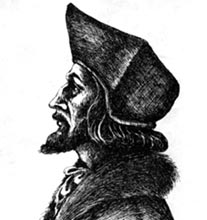 The name John Hus is not well known to many modern day non-Reformed Protestants but perhaps we can think of Hus as the proto-type Martin Luther. Indeed, much of the situation was the same with Hus as it would be with Luther except the catalyst for Hus seemed to be the turmoil being caused by men who were competing to claim the office of Pope. Hus, the master of Charles University in Prague Czechoslovakia at first attempted to remain neutral in the fight but as time went on it was looking more & more like the entire papal system & perhaps Roman Catholicism itself was a wrong representation of Christianity.
The name John Hus is not well known to many modern day non-Reformed Protestants but perhaps we can think of Hus as the proto-type Martin Luther. Indeed, much of the situation was the same with Hus as it would be with Luther except the catalyst for Hus seemed to be the turmoil being caused by men who were competing to claim the office of Pope. Hus, the master of Charles University in Prague Czechoslovakia at first attempted to remain neutral in the fight but as time went on it was looking more & more like the entire papal system & perhaps Roman Catholicism itself was a wrong representation of Christianity.









